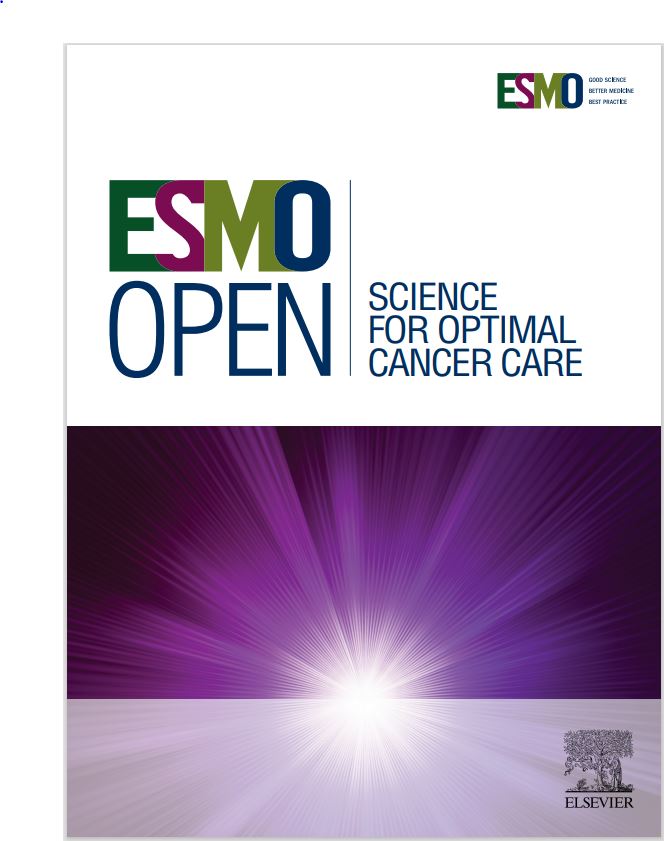Retrospective multicentric survival analysis of patients receiving TPEx regimen as first-line treatment of recurrent and/or metastatic head and neck squamous cell carcinoma
IF 7.1
2区 医学
Q1 ONCOLOGY
引用次数: 0
Abstract
Background
TPEx regimen (docetaxel, platinum, cetuximab) is a first-line treatment option for recurrent and/or metastatic head and neck squamous cell carcinoma (R/M HNSCC) if combined positive score <1, or in case of high tumor burden. We sought to evaluate the survival rates of patients receiving TPEx in real life as first-line treatment of R/M HNSCC, particularly since the advent of immunotherapy (IO) as second-line therapy.
Methods
This multicentric retrospective study included patients treated by a first cycle of TPEx between 2018 and 2023, with a performance status of 0 or 1. The primary endpoint was overall survival (OS). Secondary end-points were progression free survival (PFS1), rate of patients exposed to IO after TPEx, PFS of patients on second line treatment (PFS2).
Results
A total of 204 patients were included, mainly men (86%), previously treated for a localized HNSCC (78%). Some 32% of patients had a clinically threatening disease. Combined positive score was available for 88 patients (43%). Patients were treated with a median of four cycles of TPEx, followed by cetuximab maintenance for 154 patients. After a median follow-up of 35.8 months, median OS was 17.9 months [95% confidence interval (CI) 15.7-19.6 months], median PFS1 was 6.0 months (95% CI 5.7-6.9 months) and median PFS2 was 2.5 months (95% CI 2.0-2.8 months). Among the 182 patients who progressed under TPEx, 148 patients were exposed to IO (81.3%) in subsequent lines.
Conclusion
Median OS of 17.9 months under TPEx as first-line treatment of R/M HNSCC compares favorably with historical data. IO exposure after progression on TPEx was the rule.
接受 TPEx 方案一线治疗复发性和/或转移性头颈部鳞状细胞癌患者的回顾性多中心生存分析
tpex方案(多西紫杉醇、铂、西妥昔单抗)是复发和/或转移性头颈部鳞状细胞癌(R/M HNSCC)的一线治疗选择,如果合并阳性评分<;1,或肿瘤负担高。我们试图评估在现实生活中接受TPEx作为R/M HNSCC一线治疗的患者的生存率,特别是自从免疫治疗(IO)作为二线治疗出现以来。方法本多中心回顾性研究纳入2018年至2023年间接受第一周期TPEx治疗的患者,其表现状态为0或1。主要终点是总生存期(OS)。次要终点是无进展生存期(PFS1), TPEx后暴露于IO的患者率,二线治疗患者的PFS (PFS2)。结果共纳入204例患者,主要为男性(86%),既往治疗过局限性HNSCC(78%)。约32%的患者患有临床威胁疾病。88例(43%)患者获得联合阳性评分。154例患者接受中位4个周期的TPEx治疗,随后接受西妥昔单抗维持治疗。中位随访35.8个月后,中位OS为17.9个月[95%可信区间(CI) 15.7-19.6个月],中位PFS1为6.0个月(95% CI 5.7-6.9个月),中位PFS2为2.5个月(95% CI 2.0-2.8个月)。在TPEx治疗下进展的182名患者中,148名患者(81.3%)在后续研究中暴露于IO。结论TPEx一线治疗的中位OS为17.9个月,优于历史数据。TPEx进展后的IO暴露是规则。
本文章由计算机程序翻译,如有差异,请以英文原文为准。
求助全文
约1分钟内获得全文
求助全文
来源期刊

ESMO Open
Medicine-Oncology
CiteScore
11.70
自引率
2.70%
发文量
255
审稿时长
10 weeks
期刊介绍:
ESMO Open is the online-only, open access journal of the European Society for Medical Oncology (ESMO). It is a peer-reviewed publication dedicated to sharing high-quality medical research and educational materials from various fields of oncology. The journal specifically focuses on showcasing innovative clinical and translational cancer research.
ESMO Open aims to publish a wide range of research articles covering all aspects of oncology, including experimental studies, translational research, diagnostic advancements, and therapeutic approaches. The content of the journal includes original research articles, insightful reviews, thought-provoking editorials, and correspondence. Moreover, the journal warmly welcomes the submission of phase I trials and meta-analyses. It also showcases reviews from significant ESMO conferences and meetings, as well as publishes important position statements on behalf of ESMO.
Overall, ESMO Open offers a platform for scientists, clinicians, and researchers in the field of oncology to share their valuable insights and contribute to advancing the understanding and treatment of cancer. The journal serves as a source of up-to-date information and fosters collaboration within the oncology community.
 求助内容:
求助内容: 应助结果提醒方式:
应助结果提醒方式:


